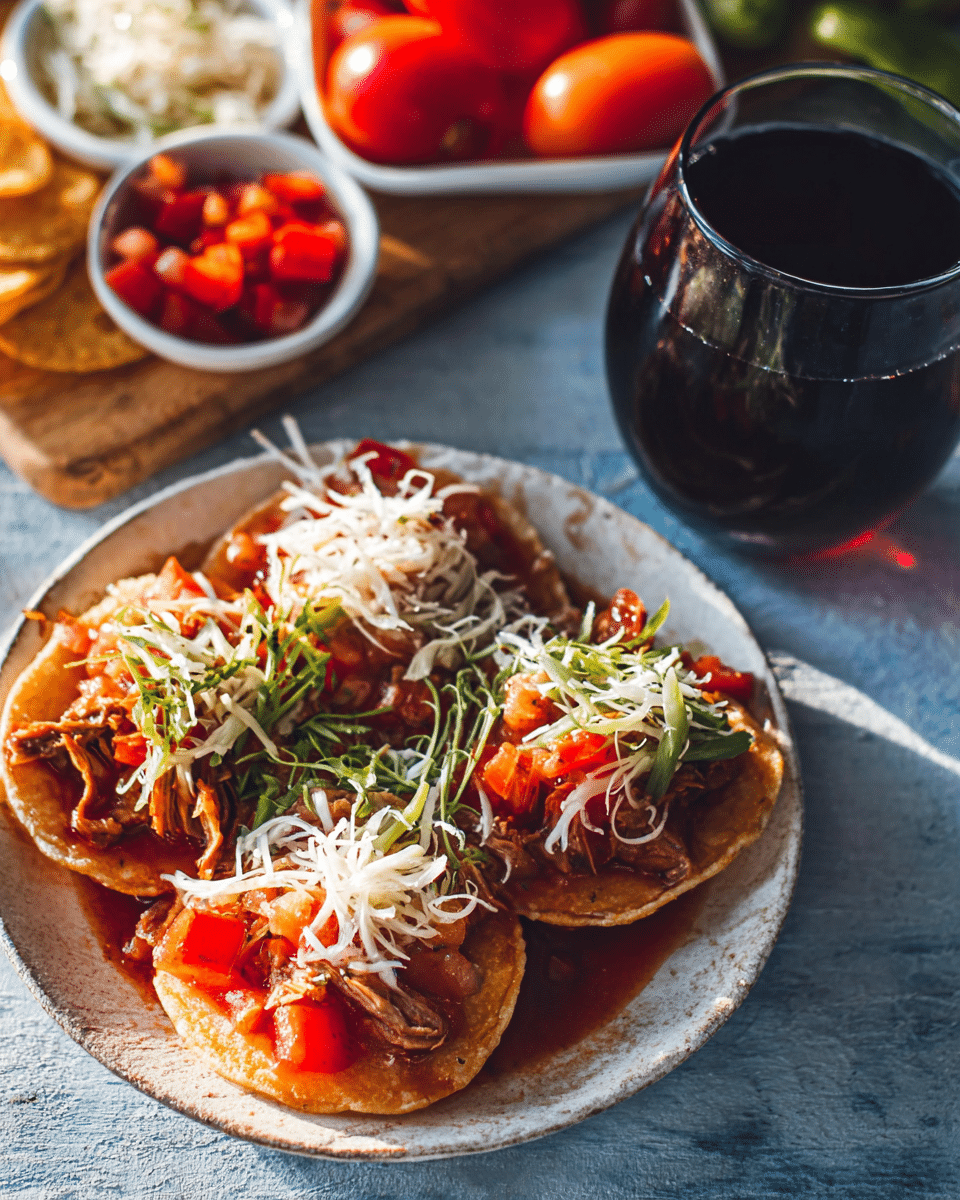Garnachas are the soul of Mexican street food comforting, hearty, and bursting with flavor. These crispy corn cakes are topped with tender shredded beef, a rich guajillo salsa, and a tangy cabbage salad that adds the perfect fresh crunch. Whether you’ve tasted them in the bustling mercados of Oaxaca or are making them at home for the first time, this dish brings a true taste of Mexico to your table.
Perfect for parties, casual dinners, or just when you want to treat yourself, garnachas are fun to eat and easy to customize. You can swap the beef for shredded chicken, pork, or even a vegetarian filling like mushrooms or zucchini. And the homemade salsa? It’s what makes the flavors pop. Serve hot with your favorite drink and enjoy every crispy, juicy bite!
Full Recipe:
Ingredients:
For the corn base:
-
3 ½ cups masa harina
-
About 2 ½ cups lukewarm water
For frying and garnish:
-
Lard or oil (as needed)
-
1 medium white onion (chopped)
-
Cotija cheese (as needed)
For the meat:
-
1 ½ lb beef brisket, flank, or chuck roast
-
1 small onion
-
2 garlic cloves (skin on)
-
2 tsp salt
For the cabbage salad (chilito):
-
½ small cabbage head, thinly sliced
-
1 small onion, thinly sliced
-
2 large carrots, grated
-
3 jalapeños, seeded and sliced into strips
-
½ Tbsp oregano
-
Juice of 1 lime
-
¼ cup white vinegar
-
Salt to taste
-
½ cup water
For the guajillo salsa:
-
1 lb tomatoes
-
3 dried guajillo or pasilla chilies, seeds and veins removed
-
3 garlic cloves
-
2 Tbsp lard or olive oil
-
Salt to taste
-
½ tsp whole black peppercorns
Directions:
-
Cook the Meat: In a large pot or slow cooker, add beef, onion, garlic, salt, and enough water to cover. Cook until tender (8 hours on low in a slow cooker or 1.5 hours on stovetop). Shred the meat once cooked and set aside.
-
Make the Cabbage Salad: Combine cabbage, onion, carrots, and jalapeños in a large bowl. Add lime juice, vinegar, oregano, water, and salt. Mix thoroughly and let rest for at least 30 minutes.
-
Prepare the Salsa: In a saucepan, combine chilies and tomatoes with water and cook until soft (10–12 min). Blend with garlic, peppercorns, salt, and 2 cups of cooking liquid. Heat oil in a pan, pour in salsa, and simmer for 10 minutes until slightly thickened.
-
Make the Corn Cakes: Combine masa harina with water until a smooth dough forms. Divide into 12 balls. Flatten each between plastic sheets into 3.5-inch discs. Cook on a hot dry skillet for 1–1.5 min on one side, flip and cook 3–4 min more. Keep warm in a towel.
-
Assemble and Fry: Heat 3–4 tbsp of oil or lard in a pan. Top each corn cake with shredded meat, then place in the pan to fry. Spoon salsa over each and add a bit of oil on top to lightly fry the toppings.
-
Once crispy on the bottom, remove and top with chopped onions and crumbled cheese. Serve immediately with cabbage salad on the side.
Prep Time: 30 minutes | Cooking Time: 1 hour | Total Time: 1 hour 30 minutes
Kcal: 191 kcal | Servings: 24 garnachas
Garnachas: A Deep Dive into Mexico’s Irresistible Street Food Tradition
In the vibrant world of Mexican street food, garnachas occupy a special place bold, rustic, and rooted in tradition. These small yet flavor-packed corn discs are topped with juicy shredded meat, salsa, and onions, then lightly fried until crispy on the edges and tender in the center. A bite into a well-made garnacha transports you straight into the bustling mercados of Oaxaca or the spirited street corners of Veracruz, where food isn’t just a meal but a cultural experience.
A Dish Born from Tradition
Garnachas have deep roots in Mesoamerican cuisine. They originate from a long-standing tradition of using corn masa (dough) as a base for various dishes. While they share some similarities with other Mexican staples like sopes or chalupas, garnachas stand out thanks to their specific preparation and presentation. The use of a thick corn tortilla that’s lightly fried while topped with savory meat and salsa creates a texture and flavor contrast that’s both comforting and indulgent.
They are typically eaten by hand, making them a favorite among street vendors and home cooks alike. Their portability, rich flavor, and versatility have made them a staple in many Mexican states, each of which adds its own twist to the dish.
Regional Variations Across Mexico
Though garnachas are enjoyed across Mexico, they vary in style and ingredients depending on the region. Each state, and sometimes even specific towns, have developed their own spin reflecting the local ingredients, traditions, and palates.
Oaxaca
In Oaxaca, garnachas are an everyday snack often found in markets and roadside stands. One distinguishing feature is the salsa, typically made with Pasilla Mixe chiles, a smoky, mildly spicy pepper unique to the region. The dish is often accompanied by chilito a type of cabbage slaw that provides a refreshing contrast to the rich toppings. In towns like Juchitán, garnachas are traditionally cooked in a comixcal, a domed clay oven that imparts a subtle earthy flavor to the dish.
Veracruz
In this Gulf Coast state, garnachas are usually made with regular thin corn tortillas rather than the thicker versions used elsewhere. Toppings often include chipotle sauce, boiled potatoes, minced meat, cheese, and sometimes black beans or chayote squash. These additions provide a balance of smoky, creamy, and earthy elements, characteristic of Veracruzano cuisine.
Puebla
In Puebla, garnachas become more of a hybrid between a garnacha and a quesadilla. They are folded in half and filled with pork meat, then fried and served with salsa verde. The Poblano version leans heavily into heartier, meat-forward profiles, making it a satisfying option for any time of day.
Yucatán
The Yucatecan take on garnachas features a thin, sope-like base garnished with frijol colado (blended black beans), picadillo (a seasoned ground meat mixture), and chiltomate, a traditional salsa made with roasted tomatoes and habanero peppers. This version is spicier and carries the unique herbal and acidic flavor notes typical of the region’s Mayan-influenced cuisine.
Mexico City (CDMX)
In Mexico City, the term “garnacha” is often used more loosely to describe any fried street snack involving masa and toppings, including sopes, huaraches, chalupas, and even tacos dorados. This broader interpretation highlights how flexible and ingrained garnachas are in the Mexican street food ecosystem.
A Symphony of Flavors and Textures
At their core, garnachas represent the perfect harmony of texture and flavor. The masa base is slightly crispy on the outside while remaining tender and chewy on the inside. The slow-cooked, shredded beef (or pork, chicken, or even a vegetarian option) provides rich, savory umami that contrasts beautifully with the tangy salsa layered on top. The addition of chopped onions, crumbled Cotija cheese, and spicy cabbage salad (chilito) adds brightness, creaminess, and a satisfying crunch.
Each bite offers complexity: smoky from dried chilies, acidic from vinegar and lime in the slaw, creamy from cheese, and meaty from the slow cooked filling. Unlike many Western dishes that rely heavily on butter or cream for richness, garnachas achieve indulgence through layers of spices, natural fats, and roasted components.
Street Food with Cultural Weight
Garnachas are more than just a food they’re a culinary expression of community and daily life in Mexico. They are most commonly sold in open-air markets, food stalls near schools and offices, or roadside carts that draw long lines at lunchtime. These vendors don’t just cook; they preserve family recipes and regional traditions passed down through generations.
Because garnachas are typically inexpensive and easy to eat on the go, they are seen as the people’s food humble, delicious, and accessible. They often serve as an introduction to Mexican street food for locals and tourists alike. And while you can now find gourmet versions in upscale restaurants, their soul remains rooted in the cobblestone streets and colorful mercados of rural and urban Mexico.
The Role of Salsa and Garnishes
No garnacha is complete without its signature salsa. From tomato-based guajillo blends to smoky pasilla sauces or spicy habanero mixes, the salsa elevates the dish from simple to unforgettable. The salsa is typically spooned over the garnachas as they fry, allowing the flavors to integrate directly into the toppings.
Garnishes like finely chopped white onion and crumbled Cotija cheese are more than decorative they offer a sharp and creamy finish that balances the heat of the salsa and the depth of the meat. The chilito, or cabbage salad, on the side is often underestimated, but it serves an essential role in cutting through the richness and adding texture and acidity.
Serving and Pairing Ideas
Garnachas are typically served hot and fresh, straight from the frying pan, topped generously and with cabbage salad on the side. A plate of garnachas makes a perfect snack, appetizer, or even main course when paired with a side of beans or a simple soup.
For drinks, garnachas pair wonderfully with agua frescas like tamarind or hibiscus, or more traditional fermented beverages such as tepache. Want something with a kick? A tamarind margarita brings both acidity and sweetness that complements the dish beautifully.
Why Garnachas Belong in Every Kitchen
The beauty of garnachas lies in their customizability. Whether you’re looking to replicate the taste of Oaxaca or give it your own twist, garnachas provide a canvas for creative expression. You can make them vegetarian, gluten-free, spicy, mild, or loaded with extra toppings depending on your audience.
They’re also great for make-ahead cooking. The meat can be slow-cooked the day before. The salsa can be stored for several days, and even the corn cakes can be prepped and frozen, then fried fresh when needed. This makes garnachas not just traditional, but also practical for modern cooking.
Conclusion:
Garnachas are the epitome of what makes Mexican street food globally beloved deeply flavorful, easy to enjoy, and rich in history. Each version tells a story of its region, of grandmothers passing down secrets, of market stalls sizzling with life. They capture the heart of a culture that celebrates bold flavors, communal eating, and culinary ingenuity.
Whether you’re a curious home cook or a seasoned food enthusiast, adding garnachas to your repertoire isn’t just about trying a new dish it’s about experiencing a piece of Mexico’s culinary soul. So next time you crave something comforting, colorful, and authentic, turn to garnachas. One bite, and you’ll understand why they’ve stood the test of time.






